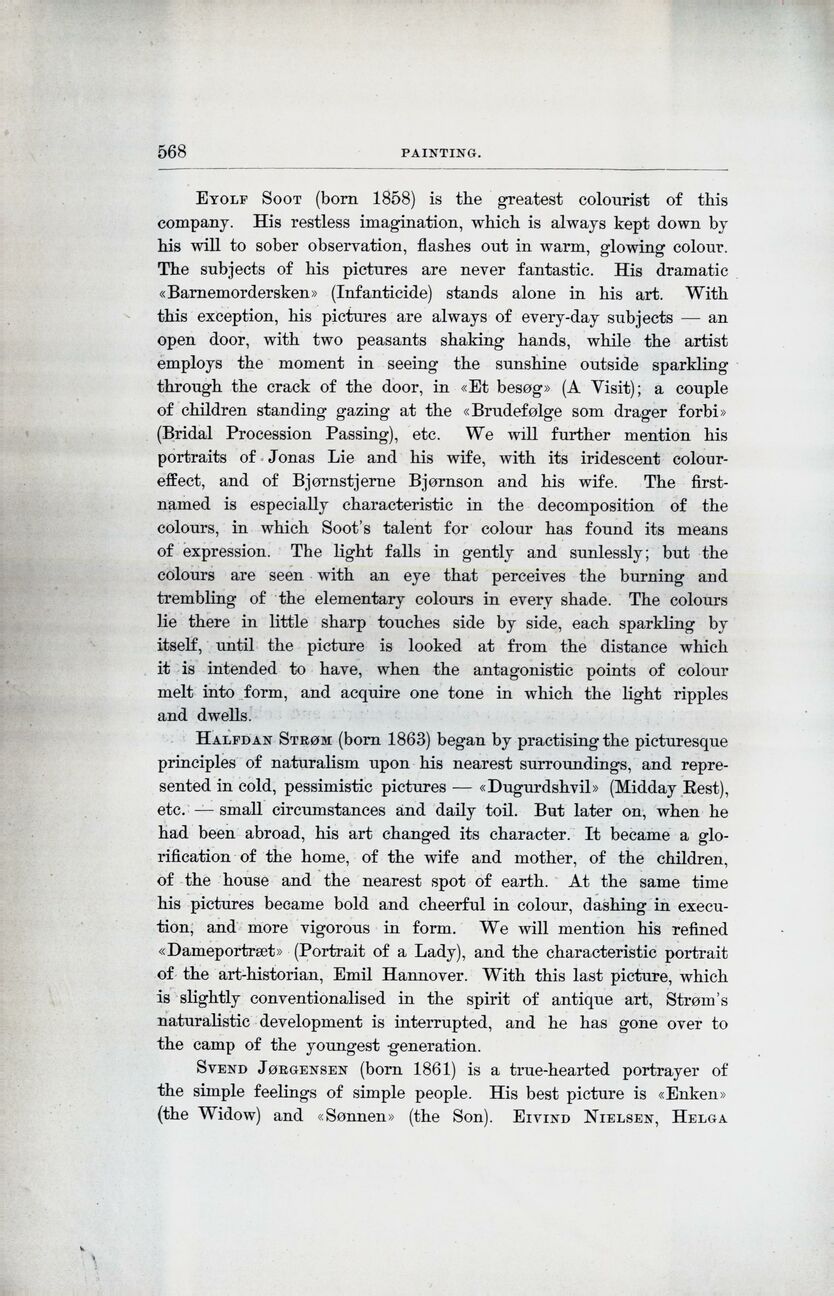
Full resolution (JPEG) - On this page / på denna sida - Painting, by Jens Thiis

<< prev. page << föreg. sida << >> nästa sida >> next page >>
Below is the raw OCR text
from the above scanned image.
Do you see an error? Proofread the page now!
Här nedan syns maskintolkade texten från faksimilbilden ovan.
Ser du något fel? Korrekturläs sidan nu!
This page has been proofread at least once.
(diff)
(history)
Denna sida har korrekturlästs minst en gång.
(skillnad)
(historik)
Eyolf Soot (born 1858) is the greatest colourist of this
company. His restless imagination, which is always kept down by
his will to sober observation, flashes out in warm, glowing colour.
The subjects of his pictures are never fantastic. His dramatic
«Barnemordersken» (Infanticide) stands alone in his art. With
this exception, his pictures are always of every-day subjects — an
open door, with two peasants shaking hands, while the artist
employs the moment in seeing the sunshine outside sparkling
through the crack of the door, in «Et besøg» (A Visit); a couple
of children standing gazing at the «Brudefølge som drager forbi»
(Bridal Procession Passing), etc. We will further mention his
portraits of Jonas Lie and his wife, with its iridescent
colour-effect, and of Bjørnstjerne Bjørnson and his wife. The
first-named is especially characteristic in the decomposition of the
colours, in which Soot’s talent for colour has found its means
of expression. The light falls in gently and sunlessly; but the
colours are seen with an eye that perceives the burning and
trembling of the elementary colours in every shade. The colours
lie there in little sharp touches side by side, each sparkling by
itself, until the picture is looked at from the distance which
it is intended to have, when the antagonistic points of colour
melt into form, and acquire one tone in which the light ripples
and dwells.
Halfdan Strøm (born 1863) began by practising the picturesque
principles of naturalism upon his nearest surroundings, and
represented in cold, pessimistic pictures — «Dugurdshvil» (Midday Rest),
etc. — small circumstances and daily toil. But later on, when he
had been abroad, his art changed its character. It became a
glorification of the home, of the wife and mother, of the children,
of the house and the nearest spot of earth. At the same time
his pictures became bold and cheerful in colour, dashing in
execution, and more vigorous in form. We will mention his refined
«Dameportræt» (Portrait of a Lady), and the characteristic portrait
of the art-historian, Emil Hannover. With this last picture, which
is slightly conventionalised in the spirit of antique art, Strøm’s
naturalistic development is interrupted, and he has gone over to
the camp of the youngest generation.
Svend Jørgensen (born 1861) is a true-hearted portrayer of
the simple feelings of simple people. His best picture is «Enken»
(the Widow) and «Sønnen» (the Son). Eivind Nielsen, Helga
<< prev. page << föreg. sida << >> nästa sida >> next page >>